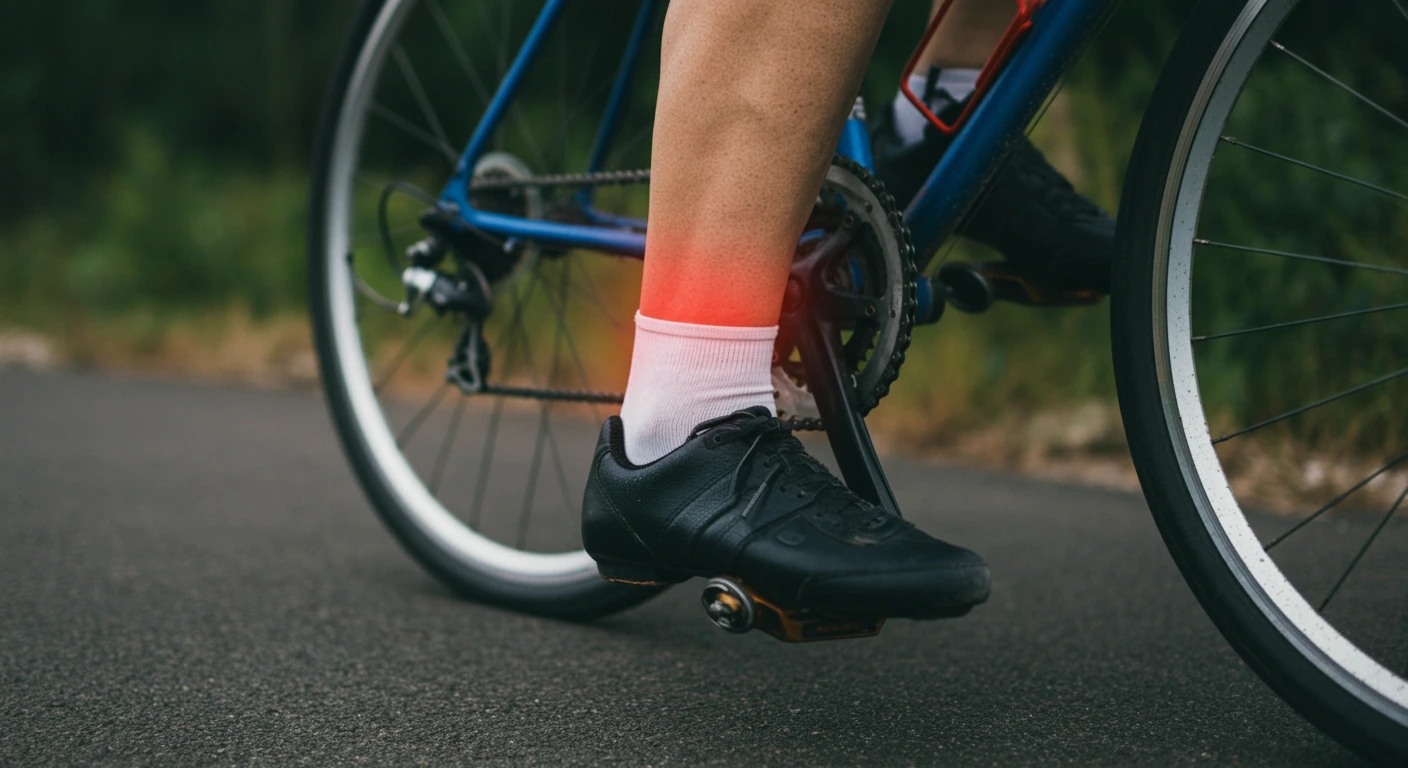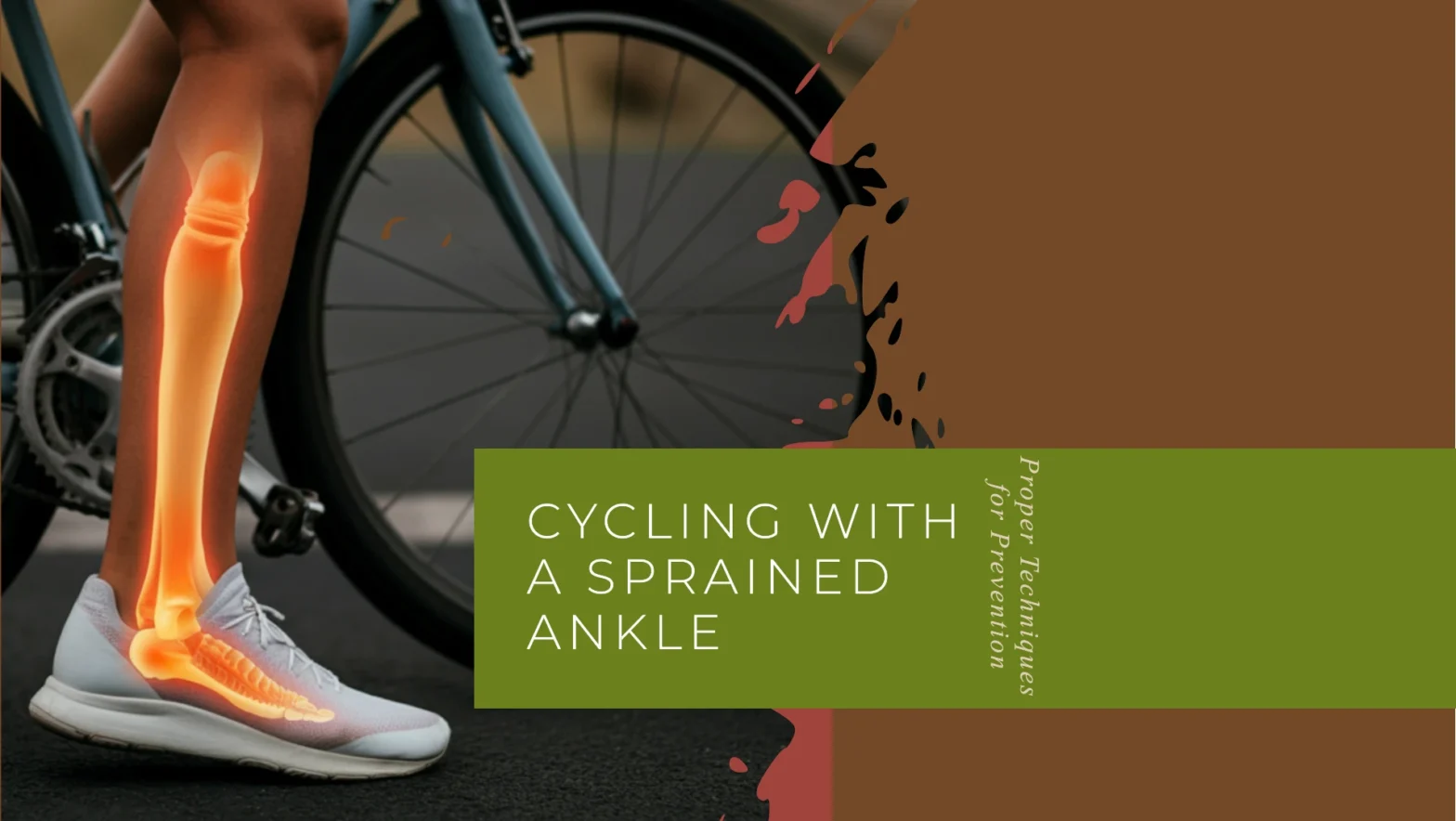Cycling is a joint exercise that can cause foot and ankle injuries. You can prevent cycling injuries by taking proper precautions and seeing an experienced sports medicine podiatrist at the first sign of trouble.
Cycling with a sprained ankle depends on the patient’s specific case and how severe the injury is. You can cycle after an ankle sprain if you don’t pedal too hard.
We will dive into all the aspects of cycling with a sprained ankle to help you make the right decision for your health and fitness.
Can You Cycle with Sprained Ankle: 3 Proper Techniques

Cycling could be a great, low-impact exercise to help you recover from the injury. Take the necessary precautions to keep yourself safe and not worsen the damage. We’ll discuss some of the proper techniques for cycling with a sprained ankle.
Choosing the Right Equipment
When cycling with a sprained ankle, it is essential to choose the right equipment. The following are some equipment recommendations for cycling after an ankle injury.
- Clipless Pedals: Clipless pedals can be an excellent choice for individuals with a sprained ankle as they provide better support and control than regular pedals.
- Flat Pedals: Flat pedals can be a more comfortable option for sprained ankles. They offer more surface area and are less likely to cause pain or discomfort.
- Road Bike: If you have a sprained ankle, a road bike can be an excellent option as it provides a more upright riding position, reducing ankle pressure.
Proper Padding and Support
Proper padding and support are essential for cyclists with sprained ankles. The following are some tips for ensuring adequate padding and support.
- Ankle Brace: Wear an ankle brace to support your sprained ankle. Ankle braces come in various sizes and provide varying levels of support. Fit it properly and make sure it provides adequate support.
- Cushioned Shoes: Wear shoes with good cushioning, especially in the ankle area. This cushioning will help absorb shock and reduce impact on your ankle.
- Gel Pads: Gel pads can be placed on the inner side of your ankle to provide additional cushioning. Gel pads provide a cushioning effect, which reduces the impact on your ankle.
Safety Measures to Avoid Further Injury
It is essential to take precautions when cycling with sprained ankles. Here are some tips on cycling with a sprained ankle.
- Cycling in a Flat Terrain: Avoid cycling in terrains that have steep climbs or descents. Stick to flat terrains when you have a sprained ankle.
- Taking Rests: Take adequate breaks when cycling to prevent fatigue and ensure your ankle is not too strained.
- Stretching: Stretching before and after cycling helps prevent further injury and helps sustain your physical well-being.
Cycling with Sprained Ankles: Alternative Exercises
You can do alternative exercises to maintain your fitness and mobility while your ankle heals. We will discuss in detail the activities that can be done to bike with a sprained ankle.
Low-Impact Aerobic Exercises

Low-impact exercises are great for anyone with an injury. They are easier on the body and put less stress on the injured area.
- Swimming: This exercise is gentle on your sprained ankle. It is a total-body workout that helps build your cardiovascular endurance.
- Elliptical training: It helps maintain cardiovascular health without placing undue stress on your ankles. Since there is no impact when using the elliptical machine, you can efficiently work your way up to longer sessions.
- Rowing: This low-impact, full-body workout is an excellent alternative for cycling while recovering from a sprained ankle.
Strengthening and Mobility Exercises
Strengthening and mobility exercises help you regain strength in the injured area and restore a normal range of motion.
- Balance exercises: These provide a great way to improve the strength of your ankle. Practicing balancing on one foot at a time can make a big difference in your ankle’s overall mobility and stability.
- Ankle circles: This exercise involves rotating your ankle clockwise and then counter-clockwise. This motion helps to loosen up the ankle joint and promotes healing.
- Heel raises: This exercise involves standing on one foot with your other slightly raised off the ground. Then, submit your heel as high as you can before bringing it back down. The muscles and tendons around the ankle are strengthened by doing this.
Physical Therapy and Rehabilitation
Physical therapy can be a great way to rehabilitate your sprained ankle and return to cycling.
- Ultrasound therapy: This non-invasive treatment uses sound waves to promote healing. Reduces ankle pain and inflammation while promoting blood flow to the area.
- Massage therapy: This provides a great way to increase blood flow and reduce soreness in the ankle.
- Active range of motion exercises: These help increase the range of motion in your ankle and reduce the likelihood of future injuries.
Sprained Ankle and Cycling: Embrace or Avoid
With a sprained ankle, it’s essential to consider whether cycling is the right option. While cycling can be a low-impact exercise, there are certain instances when it could be more advisable. Read on to find out when cycling is not recommended with a sprained ankle.
When Pain Persists
A sprained ankle requires you to listen to your body, and avoiding activities that cause excessive pain or discomfort is essential. Cycling can promote healing by increasing blood flow to the affected area. If pedaling causes sharp or intense pain, it’s best to avoid cycling until it subsides. Here are some signs that cycling with a sprained ankle may not be advisable:
- Experiencing stiffness or pain during or after cycling.
- Swelling or redness in the ankle area after cycling.
- Increasing pain or discomfort during cycling.
When the Sprain is Severe
A sprained ankle can be severe and require medical attention. If you have a severe sprain, following your doctor’s advice and avoiding activities that could worsen the injury is essential. Even at a low intensity, cycling can cause unwanted stress to the injured ankle and may prolong healing time. Cycling may not be advisable with a severe sprain:
- Affected ankle can’t bear weight.
- Severe swelling and bruising in the ankle area.
- The ankle is visibly deformed or misaligned.
When Healing Time is Insufficient
The healing time of a sprained ankle varies depending on its severity. Allowing enough time for the ankle to heal and avoiding activities that could delay the healing process is essential. If you need to know if your ankle is healed enough to cycle, it’s best to err on caution and wait for your doctor’s approval. Cycling may not be recommended due to insufficient healing time:
- Ankle stiffness and limited range of motion.
- Everyday activities, such as walking or standing, cause pain.
- Continued swelling or discomfort in the ankle area.
Ankle Sprain Cycling: Recovery & Rehabilitation Tips

When it comes to cycling, injuries such as sprained ankles can be a common occurrence. Proper care and rehabilitation make it possible to recover and return to the bike. Here are some professional tips on how to handle a sprained ankle while cycling:
Rest and Recovery Strategies
Rest is crucial for a sprained ankle to heal correctly, and engaging in physical activity can worsen the injury. Therefore, it is best to avoid cycling until the ankle has completely healed. To aid in the recovery process, the following strategies may be helpful:
- The ankle should be iced several times a day for 20 minutes.
- Elevating the affected ankle above the heart reduces swelling and promotes healing.
- Wrapping the ankle with compression bandages to provide support and stability.
- Acetaminophen and ibuprofen can alleviate pain.
Steps Towards Rehabilitation and Getting Back on the Bike:
Once the ankle has fully healed, it is essential to take gradual steps toward rehabilitation. This process may vary depending on the severity of the injury and should be done under the guidance of a professional. The following steps can aid in rehabilitation and help to get back on the bike safely:
- Start with gentle exercises that gradually increase in intensity to strengthen the ankle and help it regain flexibility.
- With a physical therapist, determine the best exercises based on your injury type and severity.
- Gradually introduce cycling back into the routine, starting with short distances and low intensity.
- Increase intensity, duration, and distance gradually to regain strength and endurance.
Sprained Ankle Cycling: Prevention Tips
Proper prevention and self-care techniques can reduce the risk of exacerbating the injury and speeding up your recovery. Here are some tips for preventing further damage to your sprained ankle and staying safe while cycling.
Maintain a Healthy Lifestyle
A healthy, active lifestyle is essential for preventing injuries. Keeping your muscles and joints strong and flexible can reduce the strain on your ankles during physical activities like cycling. Exercises that can help maintain a healthy lifestyle include:
- Cycling with the opposite leg: If you’re experiencing pain or discomfort in one ankle, consider cycling with the opposite leg to reduce the load on your injured ankle.
- Swimming: This low-impact aerobic exercise promotes blood circulation and heals injured ankles.
- Yoga and stretching: Yoga and stretching improve flexibility, balance, and coordination. Incorporating these exercises into your daily routine decreases the risk of ankle sprains and improves overall physical health.
Stretching and Proper Warm-Up Techniques
Before cycling, it’s essential to warm up your muscles and prepare them for physical activity. Proper warm-up techniques can help improve circulation, facilitate healing, and prevent further injury. Some stretching and warm-up techniques that may be helpful include:
- Ankle rotations: Perform slow, circular rotations with your ankle in both directions to stretch the muscles and joints.
- Calf stretches: Stretch the muscles and tendons in your calf by leaning against a wall, bending your front leg, and stretching out your back leg.
- Quad stretches: Slowly lift one foot, bend your knee behind you, and use your hand to pull your foot towards your buttocks. Hold for 10-15 seconds and switch to your other leg.
Proper Footwear and Safety Equipment
Wearing proper footwear and safety equipment can help prevent ankle sprains while cycling. Choosing footwear that provides adequate support for your twisted foot. Some tips for choosing proper footwear include:
- Good arch support: Good arch support distributes your weight evenly, reducing strain on ankles and other joints.
- Protected toes: Wear shoes with sturdy toe boxes to help protect your toes in case of falls or collisions.
- Cycling shoes: Consider investing in cycling shoes that provide ankle support and attachment to your pedals for better stability and control during cycling.
Conclusion
Cycling with a sprained ankle is not impossible but requires careful consideration and proper techniques. A sprained ankle is a severe injury that should not be taken lightly, and the impact of outdoor activities on healing needs to be thoroughly understood.
Whether you decide to continue cycling with a sprained ankle or not, seeking professional medical care and following a course of rehabilitation and recovery is essential.
By preventing further injuries and maintaining a healthy and active lifestyle, you can enjoy cycling safely and without any hindrance. Thank you for reading, and we hope these insights will help you make informed choices while cycling.
FAQs
Can You Exercise with A Sprained Ankle?
For a mild sprain, gentle stretches and activities such as walking and swimming may be manageable. With more severe sprains, bearing weight on the affected ankle and engaging in regular workouts can become challenging and restrict your exercise choices.
Can You Ride A Stationary Bike With A Sprained Ankle?
Yes, riding a bike with a sprained ankle is possible, but it’s essential to proceed with caution and listen to your body. Here are some guidelines to follow:
- Rest: Give your ankle a few days until you can support your weight without pain.
- Start Slowly: Begin with a light 20-minute bike ride, focusing on smooth and easy pedaling. Pay close attention to how your ankle feels during and after the ride.
- Repeat Gradually: If the initial ride goes well and your ankle feels okay afterward, repeat the ride every few days and slowly increase the duration as your ankle strengthens and heals.
- Avoid Clipless Pedals: Use regular pedals instead of clipless pedals to minimize strain on the ankle and allow for easier disengagement if needed.
- Stay Seated: Remain seated while cycling to avoid putting excessive force on your ankle, especially when pedaling uphill or accelerating.
- Listen to Your Body: If you experience any pain, discomfort, or swelling during or after cycling, adjust your routine accordingly. It’s crucial to prioritize your ankle’s recovery and not push through pain. If symptoms persist or worsen, consult a healthcare professional for further guidance.
How Soon After Bad Ankle Sprain Can You Ride A Bike?
A lighter sprain can allow you to return to riding a bike in 2-3 weeks. A more serious sprain involves a more significant injury to the ligament and may require 4-6 weeks for recovery. The most severe sprains often involve a complete tear of the ligament and can require three months or more for recovery.
Is Cycling Good For Sprained Ankle
Those recovering from ankle sprains may cycle without putting too much pressure on the pedals, which minimizes the force exerted on the sensitive ankle.


